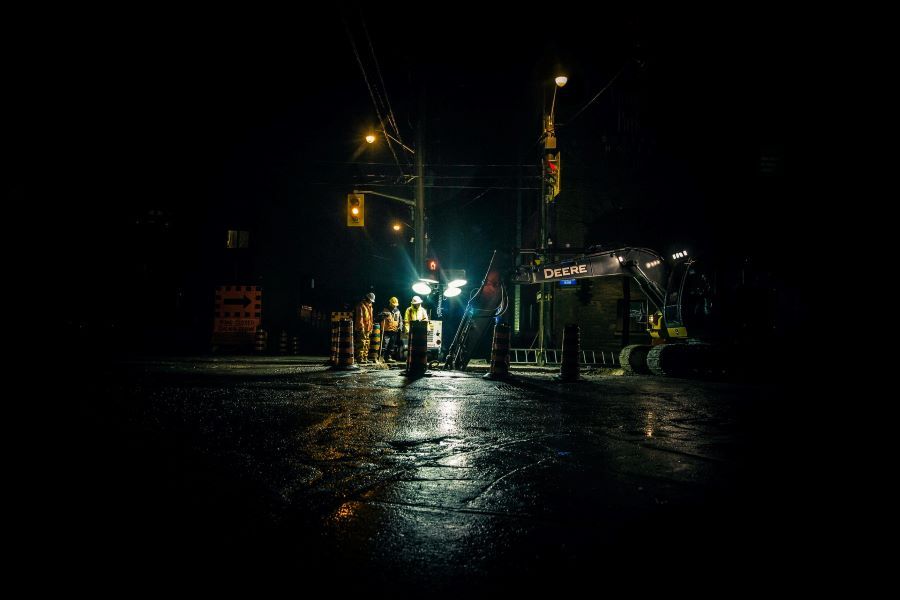Worksite Safety: Working in the Dark

By Evelyn Long
Every November, most of the United States sets its clocks back an hour as daylight saving time (DST) ends. While an hour of difference may not seem like much, it means the nights get dark sooner.
For landscaping business owners and employees working outside, that can pose some safety risks.
How daylight saving affects safety
When DST ends, the sun starts to go down before the workday is over. As a result, many outdoor workers find themselves working in the dark. That loss of visibility can make it harder to work safely.
In some areas, car crashes rise by 20 per day after the fall time change, thanks to lower visibility. The weather also starts to worsen around the same time of year. The combination of low light and poor weather can make landscaping jobs dangerous.
The time change could also throw off some workers’ internal clocks, making them tired and distracted. When employees aren’t paying attention, they’re more likely to get hurt.
How workers can stay safe
While some states have stopped recognizing DST, most workers in the U.S. still have to navigate its impacts on their schedules and bodies. Thankfully, darker workdays do not necessarily need to be dangerous. With the right preparation, workers can stay safe at any time of year. Some of the most important safety considerations for working when DST ends are as follows:
1. Illuminate the work site
The biggest safety concern after “falling back” is a lack of light. Work sites will be darker toward the end of the day, so landscaping teams need to do all they can to improve visibility. When working in the fall and winter, bring lights to every afternoon and evening job.
Night can fall faster than expected, so it’s important to set up lights before it gets dark. It’s also crucial to set lighting rigs up to illuminate workspaces from multiple angles to eliminate harsh shadows. On top of stationary lights, it may be a good idea to equip workers with headlamps or portable lanterns.
Remember that dust is more visible in all this artificial light, which can also harm visibility. Since landscaping can kick up quite a bit of dirt, workers should work slowly to avoid creating large dust clouds. Cleaning surfaces and dampening the ground can also help keep debris out of the air.
2. Wear high-visibility PPE
It’s harder to see workers who may be up high or moving around when it gets dark. That can cause employees to run into each other or passers-by to accidentally interfere with the job. The solution to these hazards is to wear high-visibility personal protective equipment (PPE).
Class 3 high-visibility clothing provides the most visibility in the broadest range of conditions, making it ideal for low-light work. This typically includes vests and jackets made of bright, fluorescent materials with strips of reflective tape.
It’s important to pick comfortable and convenient high-visibility PPE, too. While these factors don’t directly impact safety, they make workers more likely to comply with rules and wear them. Remember that they should also work with safety equipment such as harnesses.
3. Ensure proper rest
While visibility is the most pressing DST safety concern, rest may also be an issue. The early sunset may make workers feel more tired than normal, and all the artificial light can interfere with circadian rhythms, leading to more tiredness.
Being tired or distracted at heights or when handling heavy equipment can be risky. As a result, team leaders should make sure everyone is well rested for evening jobs. Look for signs of fatigue as people work, and ensure everyone gets a break at some point.
If possible, scheduling the most taxing or risky work for earlier in the day is ideal. That way, if workers are tired later, it won’t impact their safety as much. Offering healthy snacks and water can also help employees maintain their energy.
The time change at the end of DST can take a bit to get used to, but it doesn’t have to be dangerous. If landscaping teams follow these steps, they can operate safely despite an earlier sunset. No matter what time of year they’re working, they can do so without fear of injury.
Evelyn Long is a writer and editor focused on home building and construction. She is the co-founder of Renovated, a web magazine for the home industry.


